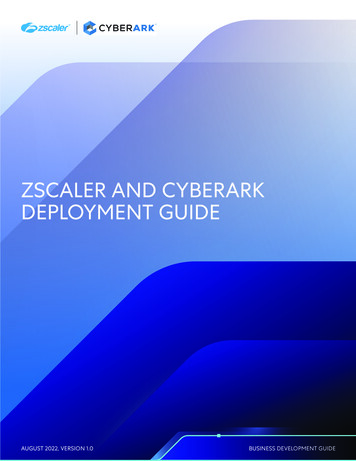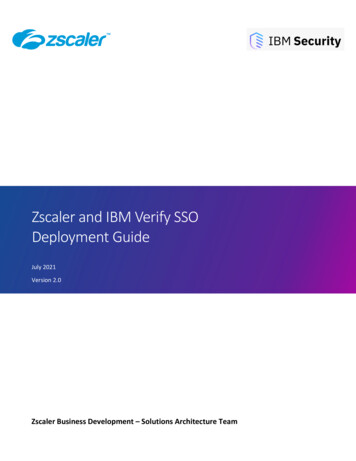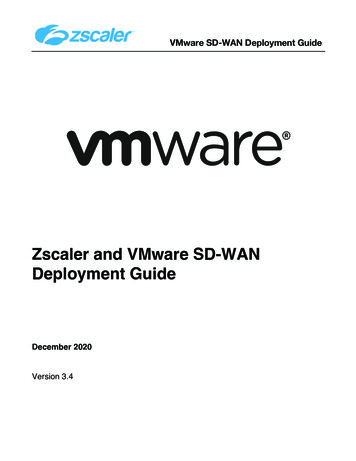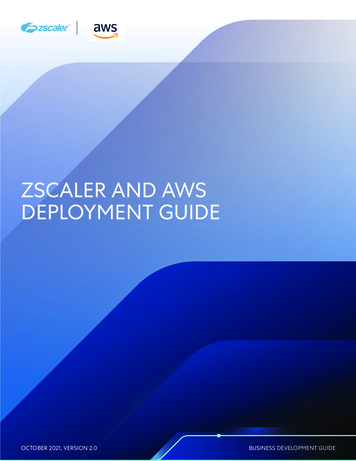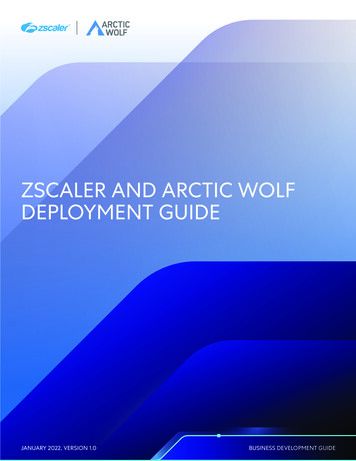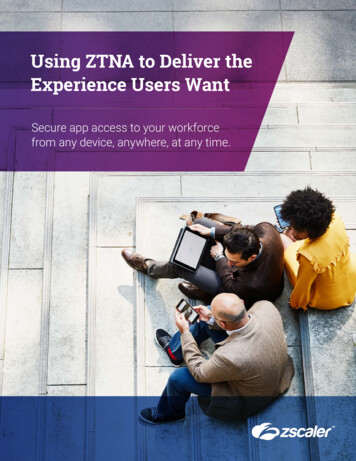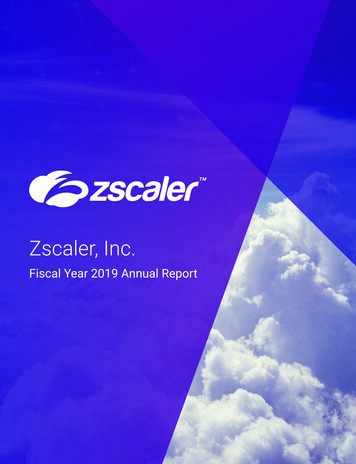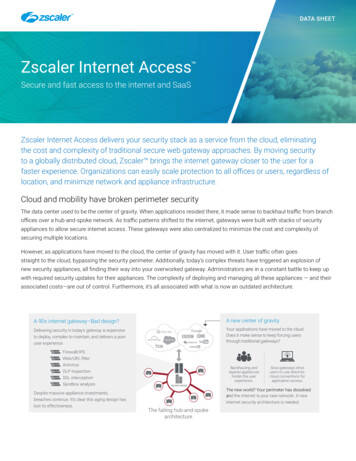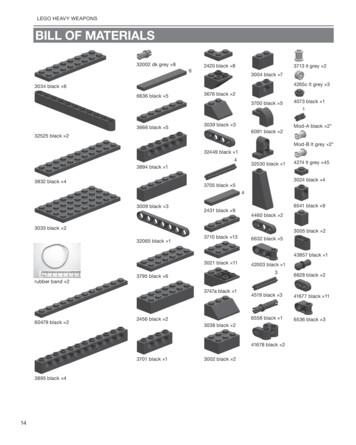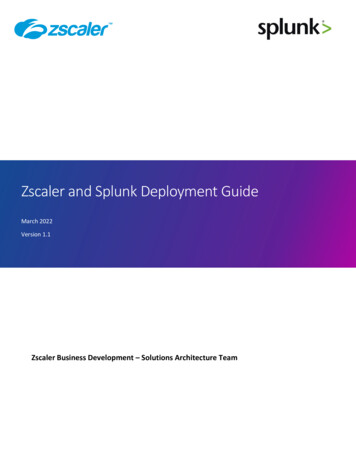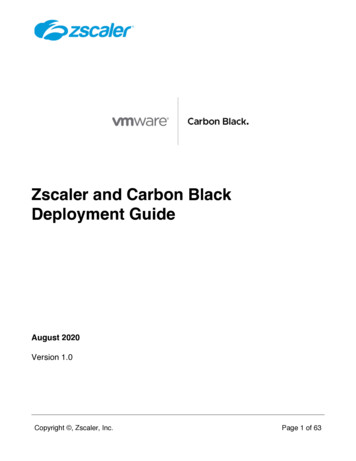
Transcription
Zscaler and Carbon BlackDeployment GuideAugust 2020Version 1.0Copyright , Zscaler, Inc.Page 1 of 63
/ Zscaler & Carbon Black Deployment GuideTable of Contents1 Zscaler Integrations with Carbon Black. 71.11.21.3Use Case I: Zscaler Sandbox Patient Zero . 8Use Case II: Zscaler Sandbox Connector . 9Use Case III: ZPA Posture Check . 102 Use Case I: Configure CB Enterprise EDR (CB Threat Hunter) . 112.12.22.32.42.52.62.72.82.92.10Configuring Carbon Black for ZIA - Overview . 11Logging into Carbon Black . 12Navigate to API Access . 13Carbon Black Org Key and Org ID . 14Navigate to Access Levels . 15Add New API Access Level . 16Create API Access level . 17Add API Key . 18Create API Key tied to Access Level from previous step . 19Note the API Credentials . 203 Use Case I: Configure CB Endpoint Standard (CB Defense) . guring Carbon Black for ZIA - Overview . 21Logging into Carbon Black . 22Navigate to API Access . 23Carbon Black Org Key and Org ID . 24Navigate to Access Levels . 25Add New API Access Level . 26Create API Access level . 27Add API Key . 28Create API Key tied to Access Level from previous step . 29Note the API Credentials . 30Add API Key . 31Create API Key tied to Access Level type - “API” . 32Note the API Credentials . 334 Use Case I: Configuring Zscaler Internet Access (ZIA) . 344.14.24.3Configuring Zscaler Internet Access for Carbon Black . 34Logging into Zscaler (ZIA) Admin Portal . 34Configure Partner Integration . 354.3.14.3.24.3.34.4If integrating with Enterprise EDR (Threat Hunter) only . 35If integrating with Endpoint Standard (CB Defense) only . 37If integrating with both, Endpoint Standard and Enterpriser EDR (TH & Defense) . 39Activate Pending ZIA Configuration . 41Copyright , Zscaler, Inc.Page 2 of 63
/ Zscaler & Carbon Black Deployment Guide5 Use Case I: Viewing Carbon Black Endpoint Hits. 425.15.25.35.45.55.65.75.85.9Navigate to Web Insights . 42Select Logs . 43Filter on Sandbox related logs . 44Confirm whether sandbox was involved . 45Access Zscaler Sandbox Report . 46Zscaler Sandbox Report . 47Access Carbon Black Endpoint Hits Report . 48Network Contain an Endpoint . 49Confirm endpoint quarantine status . 506 Use Case II: Zscaler Sandbox Connector for Carbon Black Cloud . 516.16.26.36.46.56.6Overview . 51Requirements . 51License . 51Support . 52Installation . 52Configuration . 536.6.16.6.26.7Carbon Black Configuration . 53Zscaler Configuration . 55Running the Script . 576.7.1Examples . 577 Use Case III: ZPA Posture Check . 587.1Use Case III: Overview . 588 Appendix A: Requesting Zscaler Support . 598.1Gather Support Information . 598.1.18.1.2Save Company ID . 60Enter Support Section . 619 Appendix B: Zscaler Resources . 6210 Appendix C: Carbon Black Resources . 63Copyright , Zscaler, Inc.Page 3 of 63
/ Zscaler & Carbon Black Deployment GuideTerms and AcronymsAcronymDefinitionCACentral Authority (Zscaler)CSVComma-Separated ValuesDPDDead Peer Detection (RFC 3706)GREGeneric Routing Encapsulation (RFC2890)IKEInternet Key Exchange (RFC2409)IPSecInternet Protocol Security (RFC2411)PFSPerfect Forward SecrecyPSKPre-Share KeySSLSecure Socket Layer (RFC6101)XFFX-Forwarded-For (RFC7239)ZIAZscaler Internet Access (Zscaler)ZENZscaler Enforcement Node (Zscaler)ZPAZscaler Private Access (Zscaler)Copyright , Zscaler, Inc.Page 4 of 63
/ Zscaler & Carbon Black Deployment GuideAbout This DocumentZscaler OverviewZscaler (Nasdaq: ZS), enables the world’s leading organizations to securely transform theirnetworks and applications for a mobile and cloud-first world. Its flagship services, ZscalerInternet Access and Zscaler Private Access, create fast, secure connections between usersand applications, regardless of device, location, or network. Zscaler services are 100% clouddelivered and offer the simplicity, enhanced security, and improved user experience thattraditional appliances or hybrid solutions are unable to match. Used in more than 185countries, Zscaler operates a massive, global cloud security platform that protects thousandsof enterprises and government agencies from cyberattacks and data loss. For moreinformation on Zscaler, please visit www.zscaler.com or follow them on Twitter @zscaler.Carbon Black OverviewVMware Carbon Black (Nasdaq: VMW) is a leader in cloud-native endpoint protectiondedicated to keeping the world safe from cyberattacks. The VMware Carbon Black Cloudconsolidates endpoint protection and IT operations into an endpoint protection platform (EPP)that prevents advanced threats, provides actionable insight and enables businesses of allsizes to simplify operations. By analyzing billions of security events per day across the globe,VMware Carbon Black has key insights into attacker’s behaviors, enabling customers todetect, respond to and stop emerging attacks.With Carbon Black, customers benefit from better protection, better performance andimmediate time-to-value delivered by the cloud-native platform.Copyright , Zscaler, Inc.Page 5 of 63
/ Zscaler & Carbon Black Deployment GuideAudienceThis guide is written for network administrators, endpoint / IT administrators, and securityanalysts responsible for deploying, monitoring and managing enterprise security systems. Foradditional product and company resources, please refer to the Appendix section.Software RevisionsThis document was authored using Zscaler Internet Access and Carbon Black Agent version3.5.0.1756 on Windows 7 and Windows 10.Request for CommentsWe value the opinions and experiences of our readers. To offer feedback or corrections for thisguide, please contact us at partner-doc-support@zscaler.com.Copyright , Zscaler, Inc.Page 6 of 63
/ Zscaler & Carbon Black Deployment Guide1Zscaler Integrations with Carbon BlackZscaler Internet Access (ZIA) is a Secure internet and Web Gateway delivered from the cloud.Offered as a service from the world’s largest security cloud, ZIA provides a fully integratedsecurity stack including SSL inspection, web gateway, firewall, bandwidth control, DLP andmore. Its single-scan, multi-action architecture enables highly performant security protection tocompanies large and small over 185 countries worldwide.Zscaler Private Access (ZPA) is a cloud service that uses a distributed architecture to providefast and secure access to private applications running on-prem or in the public cloud.Carbon Black Security products set the new standard with cloud-native security platform thatdelivering endpoint breach prevention solution that unifies NGAV, EDR, managed threathunting and threat intelligence automation in a single cloud-delivered agent.The integration of the two platforms unites the two market leaders and provides end-to-endvisibility and protection from endpoint to applications in the cloud. The resulting integratedsolution can enable cross-platform workflows that reduce dwell time and mean-time-toremediate (MTTR).Copyright , Zscaler, Inc.Page 7 of 63
/ Zscaler & Carbon Black Deployment Guide1.1§§Use Case I: Zscaler Sandbox Patient ZeroZIA detects zero-day malicious file via Zscaler Cloud Sandbox and produces an InsightLog about the file hash along with the relevant Carbon Black endpoint telemetry data inthe same report. The endpoint data is retrieved dynamically via an API sessionestablished by a one-time setup process at the Zscaler console.The same report also includes a contain/quarantine action button, which enablesadministrator to trigger a network contain/quarantine request to Carbon Black platform.A network contained/quarantined host can only talk to Carbon Black backend IPs andIPs explicitly whitelisted by the Carbon Black admin. All other network access is cut off.See below for a conceptual diagram of the integrationFigure 1: Zscaler Sandbox Patient Zero - High Level OverviewCopyright , Zscaler, Inc.Page 8 of 63
/ Zscaler & Carbon Black Deployment Guide1.2Use Case II: Zscaler Sandbox Connector§While Zscaler can scan all files before they reach the endpoint if they come through thenetwork, what happens when a file comes in via another method? Also, how do we findmore information about files that landed on the end host prior to CB sensor installation?§The connector will scan for any CBC Enterprise Standard (formerly CB Defense) eventsor CBC Enterprise EDR (formerly CB Threat Hunter) processes. After pulling theprocesses, it checks all of the unique hashes against a database of files that have beenchecked in the past. If the file is not known, a request to Zscaler's ZIA Sandbox is madeto see if they have any information on it. If they do, or if the file is known bad from thelocal database, action is taken.See below for a conceptual diagram of the integrationFigure 2: Zscaler Sandbox Connector - High Level OverviewCopyright , Zscaler, Inc.Page 9 of 63
/ Zscaler & Carbon Black Deployment Guide1.3Use Case III: ZPA Posture Check§The device posture profile is a set of criteria that a user’s device must meet in order toaccess applications with ZPA. You can select a device posture profile whenconfiguring access policies in the ZPA Admin Portal. However, you must configurethese device posture profiles in the Zscaler Client Connector Portal§ZPA can be configured to make Zscaler App (client connector) check and confirm forthe presence of running Carbon Black agent and allow access to sensitive applicationsonly if this posture check passesSee below for a conceptual diagram of the integrationFigure 3: ZPA Posture Check - High Level OverviewCopyright , Zscaler, Inc.Page 10 of 63
/ Zscaler & Carbon Black Deployment Guide2Use Case I: Configure CB Enterprise EDR (CB ThreatHunter)2.1Configuring Carbon Black for ZIA - OverviewZscaler ZIA sandbox integrates with two Carbon Black endpoint protections products Enterprise EDR (formerly known as Threat Hunter) and Endpoint Standard (formerly knownas CB Defense) If you license to CB Threat Hunter only, follow setup instructions in this sectionIf you license to CB Defense only, skip this section and follow setup instructionsin the next section (section 3)If you license to both CB products, follow setup instructions in both the sectionsTo establish the API connection between Carbon Black and Zscaler, an API client and keyneed to be first generated from the Carbon Black console and then input into the ZscalerAdmin portal along with a few other Carbon Black tenant specific details.Zscaler needs Carbon Black Cloud Service hostname, API ID/Secret Key and Org ID/keyto establish the API connection.The following steps assume that Carbon Black platform as well as Carbon Black sensors havebeen deployed and properly configured. If this has not been done, please refer to CarbonBlack documentation to deploy and configure Carbon Black components ise-endpoint-detection-and-response/Copyright , Zscaler, Inc.Page 11 of 63
/ Zscaler & Carbon Black Deployment Guide2.2Logging into Carbon BlackLog into Carbon Black using your administrator account. If you are unable to log in using youradministrator account, please contact Carbon Black support (Appendix C).Figure 4: Log into Carbon Black portalCopyright , Zscaler, Inc.Page 12 of 63
/ Zscaler & Carbon Black Deployment Guide2.3Navigate to API AccessAfter logging into Carbon Black portal, navigate to API Access option as shown below.Figure 5: Navigate to API AccessCopyright , Zscaler, Inc.Page 13 of 63
/ Zscaler & Carbon Black Deployment Guide2.4Carbon Black Org Key and Org IDNote down your Org Key and Org ID. We will need to paste this later in Zscaler UI.Figure 6: Note down Carbon Black Org Key/IDCopyright , Zscaler, Inc.Page 14 of 63
/ Zscaler & Carbon Black Deployment Guide2.5Navigate to Access LevelsNavigate to Access LevelsFigure 7: Navigate to Access LevelCopyright , Zscaler, Inc.Page 15 of 63
/ Zscaler & Carbon Black Deployment Guide2.6Add New API Access LevelWe will create a new API Access level i.e. API Scope with specific permissions required for ourZscaler Sandbox integration use case. This is a part of one-time setup.Click Add Access Level as shown below.Figure 8: Add Access LevelCopyright , Zscaler, Inc.Page 16 of 63
/ Zscaler & Carbon Black Deployment Guide2.7Create API Access levelCreate an API Access Level (scope) with following permissions:§§§Execute only for Device QuarantineCreate and Read for Threat Hunter eventsRead only for Device General informationOnce completed, click Save.Figure 9: Create & Save custom API Access LevelCopyright , Zscaler, Inc.Page 17 of 63
/ Zscaler & Carbon Black Deployment Guide2.8Add API KeyNow we will create the actual API ID/Secret key and associate it with the newly created AccessLevel. Navigate back to API Keys section and click on Add API KeyFigure 10: Add API KeyCopyright , Zscaler, Inc.Page 18 of 63
/ Zscaler & Carbon Black Deployment Guide2.9Create API Key tied to Access Level from previous stepSelect Custom from the Access Level type drop down and then in Custom Access Leveldropdown, select the access level created in previous step. After naming the key, click SaveFigure 11: Create API credentialsCopyright , Zscaler, Inc.Page 19 of 63
/ Zscaler & Carbon Black Deployment Guide2.10 Note the API CredentialsTake a note of your API ID and API Secret key. We will need to paste them in ZIA UIFigure 12: Note down API credentialsCopyright , Zscaler, Inc.Page 20 of 63
/ Zscaler & Carbon Black Deployment Guide3Use Case I: Configure CB Endpoint Standard (CBDefense)3.1Configuring Carbon Black for ZIA - OverviewZscaler ZIA sandbox integrates with two Carbon Black endpoint protections products Endpoint Standard (formerly known as CB Defense) and Enterprise EDR (formerly knownas Threat Hunter) If you license to CB Defense only, follow setup instructions in this sectionIf you license to CB Threat Hunter only, skip this section and follow setupinstructions in the previous section (section 2)If you license to both CB products, follow setup instructions in both sectionsTo establish the API connection between Carbon Black and Zscaler, two separate API clientsand keys need to be first generated from the Carbon Black console and then input into theZscaler Admin portal along with a few other Carbon Black tenant specific details.Zscaler needs Carbon Black Cloud Service hostname, 2 separate API IDs/Secret Keysand Org ID/key to establish the API connection.The following steps assume that Carbon Black platform as well as Carbon Black sensors havebeen deployed and properly configured. If this has not been done, please refer to CarbonBlack documentation to deploy and configure Carbon Black components ise-endpoint-detection-and-response/Copyright , Zscaler, Inc.Page 21 of 63
/ Zscaler & Carbon Black Deployment Guide3.2Logging into Carbon BlackLog into Carbon Black using your administrator account. If you are unable to log in using youradministrator account, please contact Carbon Black support (Appendix C).Figure 13: Log into Carbon Black portalCopyright , Zscaler, Inc.Page 22 of 63
/ Zscaler & Carbon Black Deployment Guide3.3Navigate to API AccessAfter logging into Carbon Black portal, navigate to API Access option as shown below.Figure 14: Navigate to API AccessCopyright , Zscaler, Inc.Page 23 of 63
/ Zscaler & Carbon Black Deployment Guide3.4Carbon Black Org Key and Org IDNote down your Org Key and Org ID. We will need to paste this later in Zscaler UI.Figure 15: Note down Carbon Black Org Key/IDCopyright , Zscaler, Inc.Page 24 of 63
/ Zscaler & Carbon Black Deployment Guide3.5Navigate to Access LevelsNavigate to Access Levels. CB Defense integration requires 2 different API keys (in additionto Org key/ID) that are tied to 2 different Access Levels.Figure 16: Navigate to Access LevelCopyright , Zscaler, Inc.Page 25 of 63
/ Zscaler & Carbon Black Deployment Guide3.6Add New API Access LevelWe will create a new API Access level i.e. API Scope with specific permissions required for ourZscaler Sandbox integration use case. This will be used to create 1st set of API credentialsrequired for integration with ZIA sandbox. This is a part of one-time setup.Click Add Access Level as shown below.Figure 17: Add Access LevelCopyright , Zscaler, Inc.Page 26 of 63
/ Zscaler & Carbon Black Deployment Guide3.7Create API Access levelCreate an API Access Level (scope) with following permissions:§§§Execute only for Device QuarantineRead only for Org alertsRead only for Device General informationOnce completed, click Save.Figure 18: Create & Save custom API Access LevelCopyright , Zscaler, Inc.Page 27 of 63
/ Zscaler & Carbon Black Deployment Guide3.8Add API KeyNow we will create the actual API ID/Secret key and associate it with the newly created AccessLevel. Navigate back to API Keys section and click on Add API KeyFigure 19: Add API KeyCopyright , Zscaler, Inc.Page 28 of 63
/ Zscaler & Carbon Black Deployment Guide3.9Create API Key tied to Access Level from previous stepSelect Custom from the Access Level type drop down and then in Custom Access Leveldropdown, select the access level created in previous step. After naming the key, click SaveFigure 20: Create API credentials tied to Custom Access Level for CB DefenseCopyright , Zscaler, Inc.Page 29 of 63
/ Zscaler & Carbon Black Deployment Guide3.10 Note the API CredentialsTake a note of your API ID and API Secret key. We will need to paste them in ZIA UIFigure 21: Note down 1st set of API credentialsCopyright , Zscaler, Inc.Page 30 of 63
/ Zscaler & Carbon Black Deployment Guide3.11 Add API KeyNow we’ll create one more set of API keys. We don’t need to create any custom Access Level.Navigate back to API Keys section & click Add API KeyFigure 22: Add API KeyCopyright , Zscaler, Inc.Page 31 of 63
/ Zscaler & Carbon Black Deployment Guide3.12 Create API Key tied to Access Level type - “API”Select API from the Access Level type drop down.After naming the key, click SaveFigure 23: Create API credentials tied to built-in “API” Access Level for CB DefenseCopyright , Zscaler, Inc.Page 32 of 63
/ Zscaler & Carbon Black Deployment Guide3.13 Note the API CredentialsTake a note of your API ID and API Secret key. We will need to paste them in ZIA UIThis is the 2nd pair of credentials required for integrating Zscaler Sandbox with CB DefenseFigure 24: Note down 2nd set of API credentialsCopyright , Zscaler, Inc.Page 33 of 63
/ Zscaler & Carbon Black Deployment Guide4Use Case I: Configuring Zscaler Internet Access (ZIA)4.1Configuring Zscaler Internet Access for Carbon BlackEndpoint telemetry data from Carbon Black Platform is passed onto Zscaler console via an APIintegration. Correlating the endpoint data enables Zscaler console to display the Sandboxreport along with information about the originating endpoint device and other infectedendpoints in the environment, including Carbon Black Agent ID, Host Name, the time when themalicious file appeared on the endpoint (perhaps infection via a different attack surface, suchas via a USB thumb drive). This automatic correlation of malware detection with an endpointdevice reduce time and effort needed for investigation and remediation. In this section, we willconfigure the Zscaler Admin Portal with the credentials gathered in the previous section.4.2Logging into Zscaler (ZIA) Admin PortalLog into Zscaler Internet Access (ZIA) portal using your administrator account, as show inFigure 11. If you are unable to log in using your administrator account, please contact ure 25: Log into Zscaler Admin portalCopyright , Zscaler, Inc.Page 34 of 63
/ Zscaler & Carbon Black Deployment Guide4.3Configure Partner Integration4.3.1 If integrating with Enterprise EDR (Threat Hunter) onlyAfter logging in, you will arrive at the main landing page of the admin portal. From herenavigate to: Administration - Partner Integration - Carbon Black. Select Threat Huntertab. Paste your Threat Hunter API ID/Secret key and Org ID/key here. Cloud ServiceHostname depends on the location of your Carbon Black tenant. Please refer to link below foridentifying the Hostname pertinent to your CB environment (Appendix C). Click Save.Figure 26: Configure Partner Integration (Threat Hunter)Copyright , Zscaler, Inc.Page 35 of 63
/ Zscaler & Carbon Black Deployment GuideClicking Save will trigger an API call to Carbon Black to verify the credentials. If you see thegreen message “Valid API token(s)”, then you have successfully configured the API connectionfor the ZIA sandbox and Threat Hunter integration to work.Figure 27: Verify Partner IntegrationCopyright , Zscaler, Inc.Page 36 of 63
/ Zscaler & Carbon Black Deployment Guide4.3.2 If integrating with Endpoint Standard (CB Defense) onlyAfter logging in, you will arrive at the main landing page of the admin portal. From herenavigate to: Administration - Partner Integration - Carbon Black. Select CB Defensetab. Paste both of your CB Defense API IDs/Secret keys and Org ID/key to correspondingsections. Cloud Service Hostname depends on the location of your Carbon Black tenant.Please refer to link below for identifying the Hostname pertinent to your CB environment(Appendix C). Click Save.Figure 28: Configure Partner Integration (CB Defense)Copyright , Zscaler, Inc.Page 37 of 63
/ Zscaler & Carbon Black Deployment GuideClicking Save will trigger an API call to Carbon Black to verify the credentials. If you see thegreen message “Valid API token(s)”, then you have successfully configured the API connectionfor the ZIA sandbox and Threat Hunter integration to work.Figure 29: Verify Partner IntegrationCopyright , Zscaler, Inc.Page 38 of 63
/ Zscaler & Carbon Black Deployment Guide4.3.3 If integrating with both, Endpoint Standard and Enterpriser EDR (TH &Defense)After logging in, you will arrive at the main landing page of the admin portal. From herenavigate to: Administration - Partner Integration - Carbon Black.Select CB Defense and Threat Hunter tabPaste Threat Hunter API ID/Key, both of your CB Defense API IDs/Secret keys and OrgID/key to corresponding sections.Cloud Service Hostname depends on the location of your Carbon Black tenant. Please referto link below for identifying the Hostname pertinent to your CB environment (Appendix C)Click Save.Figure 30: Configure Partner Integration (CB Defense & Threat Hunter)Copyright , Zscaler, Inc.Page 39 of 63
/ Zscaler & Carbon Black Deployment GuideClicking Save will trigger an API call to Carbon Black to verify the credentials. If you see thegreen message “Valid API token(s)”, then you have successfully configured the API connectionfor the ZIA sandbox and Threat Hunter integration to work.Figure 31: Verify Partner IntegrationCopyright , Zscaler, Inc.Page 40 of 63
/ Zscaler & Carbon Black Deployment Guide4.4Activate Pending ZIA ConfigurationAnytime you make a change in ZIA, you will see a number over the Activation icon on the lefthand side menu. This lets you know that you have changes pending in queue for activation.When you are ready to commit all changes in queue, Hover mouse over the Activation menuand click the blue Activate button.Figure 32: Activate Pending ZIA ConfigurationCopyright , Zscaler, Inc.Page 41 of 63
/ Zscaler & Carbon Black Deployment Guide5Use Case I: Viewing Carbon Black Endpoint HitsThanks to this integration, you should be able to expect that malware detected by ZscalerCloud Sandbox will be automatically correlated with Carbon Black endpoint device information,as shown below, all within the Zscaler admin portal.5.1Navigate to Web InsightsIn Zscaler Admin Portal, Select Analytics tab, and then Web Insights.Figure 33: Navigate to Web InsightsCopyright , Zscaler, Inc.Page 42 of 63
/ Zscaler & Carbon Black Deployment Guide5.2Select LogsNext, click on the Logs tab and Add FilterIn the Add Filter dropdown box, enter “Threat Class”Figure 34: Select LogsCopyright , Zscaler, Inc.Page 43 of 63
/ Zscaler & Carbon Black Deployment Guide5.3Filter on Sandbox related logsSelect Sandbox as the Threat Class and click on Apply FiltersFigure 35: Select Sandbox filerCopyright , Zscaler, Inc.Page 44 of 63
/ Zscaler & Carbon Black Deployment Guide5.4Confirm whether sandbox was involvedOnce you click Apply Filters, if the file in question was detonated by Zscaler sandbox or iscurrently being detonated by Zscaler sandbox - you’ll see corresponding log entries on rightFigure 36: Confirm whether file was sent to sandboxCopyright , Zscaler, Inc.Page 45 of 63
/ Zscaler & Carbon Black Deployment Guide5.5Access Zscaler Sandbox ReportOn the right-hand
Zscaler (Nasdaq: ZS), enables the world's leading organizations to securely transform their networks and applications for a mobile and cloud-first world. Its flagship services, Zscaler Internet Access and Zscaler Private Access, create fast, secure connections between users and applications, regardless of device, location, or network.
